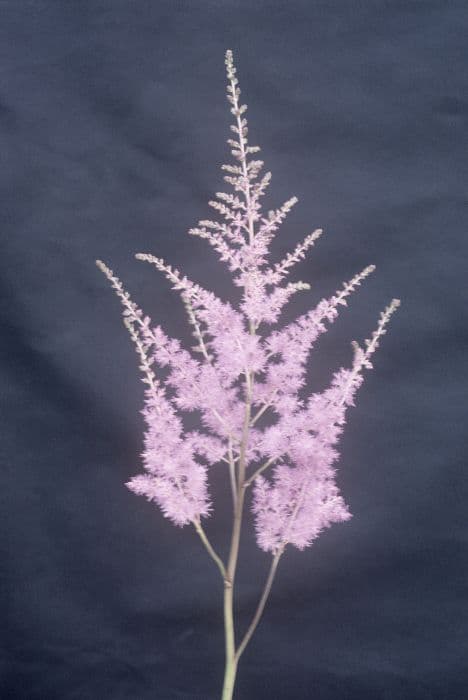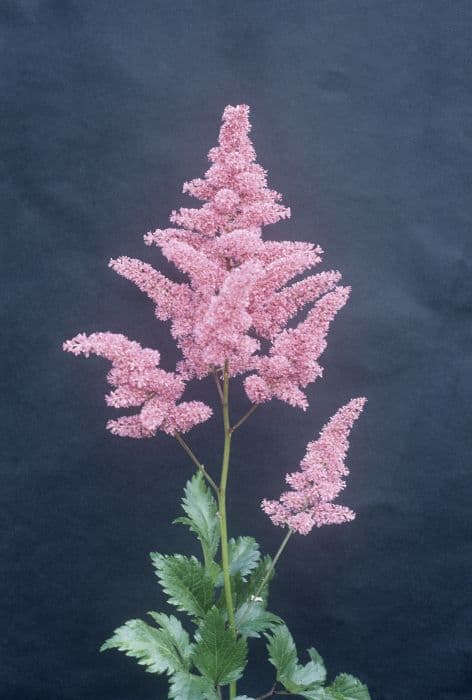Piggyback Plant Tolmiea menziesii 'Taff's Gold' (v)

ABOUT
Tolmiea menziesii 'Taff's Gold', commonly known as Piggyback Plant or Pickaback Plant, is an attractive herbaceous perennial known for its unique foliage. The leaves of 'Taff's Gold' are heart-shaped with a slightly serrated edge, giving them a soft, yet distinctive outline. They exhibit a striking variegation of colors, featuring a golden-yellow tint mixed with green hues which can appear more prominently along the veins or as a wash over the entire leaf. This variegation can add a bright splash of color to shaded garden areas or indoor plant collections. The plant's common name comes from its unusual reproductive method, wherein tiny plantlets grow on top of the mother leaf, eventually weighing the leaf down to the soil where they can take root and grow into new plants. These baby plants often appear at the base of the leaf blade near the point of petiole attachment, making the plant look as though it is carrying its offspring on its back. The appearance of the plantlets adds a layer of texture and visual interest to the Piggyback Plant. Aside from the foliage, the Piggyback Plant may also produce small, inconspicuous flowers that are brownish or greenish and often hidden amongst the leaves, but they are not the main attraction of this plant variety. Instead, it is primarily grown and cherished for its decorative leaves and the charming way it reproduces, making it a conversation starter in a collection of houseplants or shade garden specimens.
About this plant
 Names
NamesFamily
Saxifragaceae
Synonyms
Piggyback Plant, Thousand Mothers, Youth On Age, Pickaback Plant, Taff's Gold
Common names
Tolmiea menziesii 'Taff's Gold' (v)
 Toxicity
ToxicityTo humans
The most common common name for Tolmiea menziesii is Piggyback Plant. Piggyback Plant is generally considered non-toxic to humans. There is no significant evidence to suggest that it can cause poisoning if ingested. However, as with any non-food plant, it is always advisable to avoid ingestion and to keep it out of reach of small children who might chew on plants indiscriminately.
To pets
The most common common name for Tolmiea menziesii is Piggyback Plant. Piggyback Plant is not known to be toxic to pets. It does not contain any known toxic compounds that could pose a risk to cats, dogs, or other household animals if they were to ingest the plant. Nevertheless, it's always wise to monitor pets around houseplants to prevent any potential digestive upset from non-food items.
 Characteristics
CharacteristicsLife cycle
Perennials
Foliage type
Evergreen
Color of leaves
Variegated
Height
1 foot (0.3 meters)
Spread
1 foot (0.3 meters)
Plant type
Herb
Hardiness zones
6
Native area
North America
Benefits
 General Benefits
General Benefits- Easy to Care For: Taff's Gold, also known as Piggyback Plant, is low-maintenance, making it ideal for beginners or those with busy lifestyles.
- Aesthetic Appeal: Its variegated foliage with hints of gold and green adds visual interest to indoor spaces.
- Growth Habits: Piggyback Plant has a unique way of propagating by growing baby plants on top of its leaves, which can be fun to watch.
- Versatility: It can be grown in hanging baskets, as a groundcover, or in terrariums, offering various uses in home decor.
- Pet-Friendly: The plant is non-toxic to cats and dogs, making it a safe choice for pet owners.
 Medical Properties
Medical PropertiesThis plant is not used for medical purposes.
 Air-purifying Qualities
Air-purifying QualitiesThis plant is not specifically known for air purifying qualities.
 Other Uses
Other Uses- Edible Landscaping: Taff's Gold, commonly known as "Piggyback Plant," can be incorporated into edible landscaping even though the plant itself is not edible. Its ornamental value enhances the aesthetics of a vegetable garden.
- Livestock Forage: While not a common forage plant, in an emergency, Piggyback Plant could be fed to livestock as a non-toxic filler, though its nutritional value may be negligible.
- Natural Dye: The leaves of Piggyback Plant can be used to produce natural dyes for coloring textiles, although the color and fastness may vary.
- Bioindicator: This plant could be used as a bioindicator for certain types of soil conditions in environmental studies due to its specific growing preferences.
- Science Education: Piggyback Plant's unique reproductive strategy, with new plants growing from the mother leaf's surface, can be an interesting subject for botany education programs.
- Photography Subject: Its distinct foliage and color can make Piggyback Plant a compelling subject for botanical photography enthusiasts.
- Artistic Inspiration: The unique growth patterns and leaf designs of the Piggyback Plant can serve as inspiration for artists and designers.
- Living Mulch: The dense foliage can be used as living mulch in garden beds, helping to retain soil moisture and suppress weeds.
- Erosion Control: The Piggyback Plant can be effective in controlling soil erosion on slopes due to its spreading habit and ability to root at leaf nodes.
- Wildlife Shelter: The thick foliage provides small ground-dwelling wildlife with shelter and a degree of protection from predators.
Interesting Facts
 Feng Shui
Feng ShuiThe Piggyback Plant is not used in Feng Shui practice.
 Zodiac Sign Compitability
Zodiac Sign CompitabilityThe Piggyback Plant is not used in astrology practice.
 Plant Symbolism
Plant Symbolism- Youthfulness: Commonly known as "Youth on Age," Tolmiea menziesii 'Taff's Gold' carries the symbolism of youth and new beginnings, as it naturally propagates itself with new plants that grow on top of the older leaves.
- Regeneration: Its unique reproductive method also symbolizes regeneration and continuity, showcasing the plant's ability to renew and sustain its lineage.
- Parental Care: This plant is sometimes referred to as "Piggyback Plant," which underscores themes of care, nurturing, and protection, as the parent leaf supports the growth of the new plantlet.
- Prosperity: The vibrant 'Taff's Gold' variant, with its golden-colored foliage, can be associated with prosperity, wealth, and success, traditionally linked to the color gold.
 Water
WaterTo properly water a Piggyback plant, keep the soil consistently moist without letting it become waterlogged. Watering should be done once the top inch of soil feels dry. Use lukewarm water and gently pour it around the base of the plant until excess drains from the bottom, which might equate to about 8-16 ounces for a small to medium-sized pot roughly every 7-10 days, depending on the environment. During the growing season, in spring and summer, the Piggyback plant may need more frequent watering, potentially once or twice a week. In fall and winter, when the plant is not actively growing, reduce the frequency to maybe every two weeks, always checking the soil moisture level first.
 Light
LightPiggyback plant thrives in bright, indirect sunlight, such as that found near a north-facing window or a few feet away from an east- or west-facing window. Direct sunlight should be avoided as it can scorch the leaves. If the light is too low, the plant may become leggy, so it's important to find a bright spot without direct sun exposure for the best growth.
 Temperature
TemperaturePiggyback plants prefer moderate to cool temperatures, thriving ideally between 60 and 75 degrees Fahrenheit. They can tolerate a minimum of around 50 degrees Fahrenheit and should not be exposed to temperatures over 80 degrees Fahrenheit for long periods, as this can stress the plant. The ideal environment mimics their native forest floor habitat that remains cool and shaded.
 Pruning
PruningPruning the Piggyback plant encourages bushier growth and prevents it from getting leggy. Snip off any dead or yellowing leaves at their base as needed to maintain the plant's appearance and health. Pruning is best done in the spring or early summer, which is the start of its active growth period. However, it is a low-maintenance plant regarding pruning, and extensive cutting back is rarely required.
 Cleaning
CleaningAs needed
 Soil
SoilThe Pickle Plant, Tolmiea menziesii 'Taff's Gold', thrives in a well-draining, peaty or loamy soil mix, with a pH range of 5.5 to 6.5. A blend of two parts peat moss to one part perlite or fine bark will support healthy growth.
 Repotting
RepottingThe Pickle Plant should be repotted every 2-3 years or when the plant outgrows its current pot, to prevent root crowding and maintain soil nutrient levels.
 Humidity & Misting
Humidity & MistingThe Pickle Plant prefers moderate to high humidity levels, ideally between 40-60%, to emulate its native understory environment. Avoid placing in dry, arid areas.
 Suitable locations
Suitable locationsIndoor
Keep in bright, indirect light with high humidity.
Outdoor
Plant in moist, shaded area with shelter from intense sun.
Hardiness zone
6-9 USDA
 Life cycle
Life cycleTolmiea menziesii 'Taff's Gold', commonly known as Piggyback Plant, begins its life cycle as a small seed that germinates in moist, well-draining soil. Upon germination, it develops into a seedling with characteristic small, green-gold leaves. As it enters the vegetative stage, the plant continues to grow and its leaves enlarge, revealing the plant's unique trait where new plantlets form at the base of the leaf blade above the petiole. These plantlets can root themselves while still attached to the mother plant or fall off and root independently, propagating asexually. During its mature phase, the Piggyback Plant can produce inconspicuous flowers in the right conditions, although it is primarily grown for its foliage. The plant goes through a period of dormancy in colder months, significantly slowing down growth, before resuming its active growth cycle in the spring.
 Propogation
PropogationPropogation time
Spring-Early Summer
The Tolmiea menziesii 'Taff's Gold', commonly known as the Piggyback plant, is most popularly propagated through division, which can generally be done in spring or early summer. This method involves gently separating the offspring plants that grow from the base of the mature plant or from the leaf nodes. These small plantlets will often form their own roots while still attached to the parent leaf. Once these roots are substantial enough, usually about an inch (2.54 cm) in length, the plantlet can be carefully detached and potted in its own container with moist potting mix. This simple clonal method ensures that the new plants are genetically identical to the parent, retaining the distinctive 'Taff's Gold' variegation.









